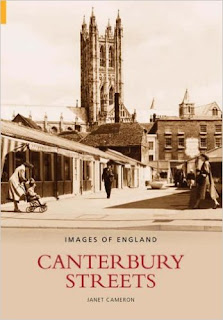Writing Local and Regional History Books
Writing local books is fun and
interesting; you get out and about to discover new places and meet new people.
You will enjoy a variety of activities, researching your material, talking to
people in libraries and museums, places of historical interest, pubs, etc. You
will surf the net for leads and images – although do make sure your security
settings and protection are up to date, and run regular scans to remove the
inevitable cookies. You can practise taking great photographs and planning the
arrangement of your material in the most accessible way.
One point about regional books is
never to assume the writing, at which you work your hardest, is synonymous with
the writing that sells the most copies. Light, easy reading about lively
subjects, like the supernatural and hauntings, criminal history and local walks
can often prove to be the most successful. The more bizarre aspects of our past
also fascinate readers. This is not, of course, to dismiss the importance of
serious local history books. These may not realise generous royalties as
quickly, but may enjoy a longer shelf-life.
Publishers' Lists
Regional/local book publishers tend
to plan their titles in series and these are then taken up by regional authors.
Usually, publishers are open to suggestions for a new series of books, or even
a one-off if you have an idea that is specific to where you live.
Alternatively, the topic you are interested in may well slot in with a
publisher's existing list, providing no other local author has got there first!
You are likely to find more
competition between authors in busy towns and cities, but this is where you are
likely to get the best sales. Find yourself a niche. The trick is to try to
find a different angle, maybe even a brand new "take" on a popular
theme.
Topics to Write About
Coastal areas offer a rich source of
exciting stories about shipwrecks, smuggling, wrecking and press-gangs – this
can also be true of towns and villages close to rivers. You can pick an area and
write about various aspects of its history, or, if you prefer, choose a
particular subject and focus on that. For example, "shipwrecks" or
"castles" can be wide-ranging in area and timeline.
If you are offered a book covering a
whole county, you can choose whether it would work better writing chapters by
topic, or use a simple A-Z format by location.
Finding Material for your Text
Material for your non-fiction stories
can be obtained in a variety of ways, by viewing old newspapers on film readers
in Local Studies, by asking your research librarians what they have in their
archives related to your subject, or by word of mouth. Whatever you find in
books or on the Internet should be dated, so that you can follow up and verify
the facts, and then write directly from the relevant source at Local Studies.
Make careful notes of all your sources, being careful about the spellings of
names, as you will need to quote and/or acknowledge them in your book. Any
books you read for background should be listed in your bibliography, by title,
author, publisher and date of publication and, bear in mind, some of your
research may contain material with subjective elements.
Use a Variety of Images
Your text wordcount will probably be
around 40,000-50,000 words (as specified by your publisher) and you'll probably
also require around 50/60 images, some of which should, ideally, be old
photographs. (Of course, for some books, old photographs would not be
appropriate, for example walking books.) It’s imperative that any old
photographs you use are either in the public domain (copyright free) or that
you secure written permission from the copyright owner to use them.
There are a number of excellent
copyright-free images on Wikipedia, and you can find them easily by keying in
"Wikipedia" and then adding the title of your topic. Then simply
click on the image to bring up its copyright status to see if you can legally
download it. It's worth researching good quality images because, although many
copyright owners are generous in asking for only a signed book or two, others
demand £70 to £100 per image. These amounts are unaffordable for most local
writers, who seldom make megabucks. Some publishers will also be happy for you
to supply one or two line drawings, if you have a knack for sketching.
Submission Guidelines
First, make every reasonable effort
to meet your deadline and if you are having difficulty, give your publisher
fair notice and ask for an extra week or two, so that they can accommodate you
without disrupting their schedule. Different publishers will have their own
preferences for the submission of your copy. You will need to follow their
guidelines for indicating where in the text each image (already coded in
sequence) should be positioned. Most publishers require a hard and an
electronic copy of the text, plus a numbered electronic copy of the photographs
and illustrations.
One of the best aspects of writing
regional and local books is that special moment when you are lucky enough to
find some new material that no one has used before. When this happens, you are
truly contributing something fresh and exciting to the common pool of local
knowledge and understanding in your area.
You may also like my article on writing books about regional murder and crime.
You may also like my article on writing books about regional murder and crime.



Comments